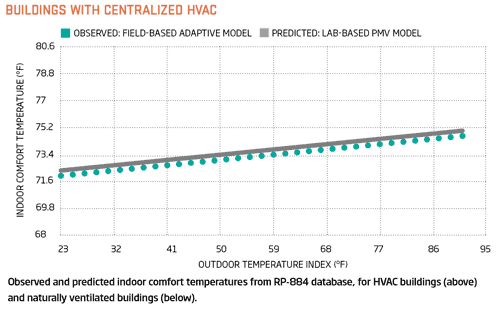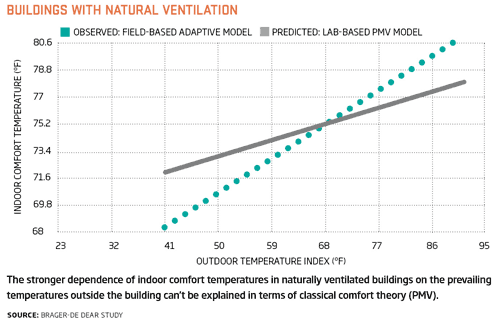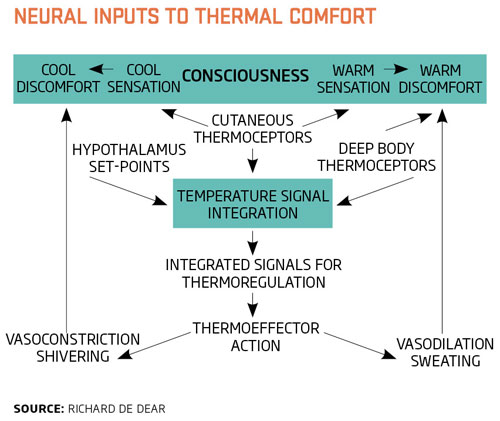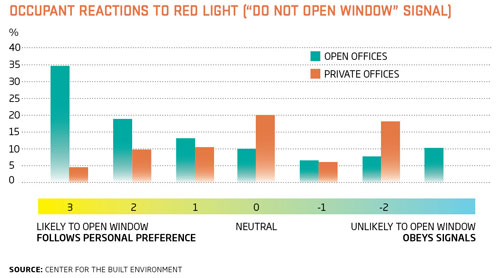The Comfort Zone
Research continues to determine when, where, and how to best implement this 'unconventional' theory to improve indoor environmental quality while reducing fossil fuel consumption.
![]() Continuing Education
Continuing Education
Use the following learning objectives to focus your study while reading this month’s Continuing Education article.
Learning Objectives - After reading this article, you will be able to:
- Explain the difference between the conventional and adaptive theories of thermal comfort.
- List the variables that affect adaptive thermal comfort.
- Understand when ASHRAE Standard 55's optional method for determining acceptable thermal conditions in naturally ventilated spaces is applicable.
- Discuss the range of research that still needs to be undertaken to optimize thermal comfort.
Prior to the age of cheap fuel, the model now known as "adaptive thermal comfort" was the rule: In warmer weather people logically opened up windows to increase air circulation and, in certain cultures, during the hottest part of the day. In cooler weather, families huddled closer together, limiting the rooms they needed to heat, and individuals added extra layers of clothing.
According to Michael A. Humphreys, emeritus professor of architecture at the School of the Built Environment at Oxford Brookes University in Oxford, UK, and an early pioneer in the field of adaptive thermal comfort, "100 years ago a wealthy London gentleman would have considered an inside temperature of 15ºC (60ºF) to be comfortable in winter," because his normal attire on a cold day would include long johns, under-vest, thick flannel shirt, waist coat, and lined jacket and trousers. In short, the adaptive thermal comfort model describes the age-old situation in which people naturally and incrementally adjusted to the typical variations in temperature associated with their region through behavioral modifications and variable expectations and preferences.
During the 20th century, at least in the most highly developed countries, new technologies running on seemingly abundant fossil fuels led to a built environment that was increasingly disconnected from the outdoors. This, coupled with new research into thermal comfort and the standards that evolved from such research, created the expectation of a fairly constant and narrow range of indoor temperatures year-round among building occupants in industrialized countries.
 |
Illustrations by Headcase |
Conventional Thinking
In the 1960s and 1970s, Professor Povl Ole Fanger at the Technical University of Denmark pioneered the conventional theory of thermal comfort, which has shaped international standards for HVAC systems ever since. Hoping to determine the ideal environmental temperature at which people could maintain their internal body temperatures, Fanger placed his subjects in a so-called climate chamber. Controlling for three environmental variables (air velocity, mean radiant temperature, and relative humidity) and two personal variables (activity levels and clothing insulation), he varied the temperatures within the chamber and calculated the degree at which most people felt no temperature difference between themselves and the surrounding environment, a state known as "thermally neutral." The people in the study were essentially passive objects-providing feedback regarding the conditions Fanger established in the climate chamber but not able to make any adjustments of their own.
From these kinds of laboratory-based studies, Fanger developed the Predicted Mean Vote (PMV) index and the Predicted Percentage Dissatisfied (PPD) index. The former predicts the temperature at which most occupants will be satisfied and the latter predicts what portion of occupants will be unhappy with a particular set of temperature and conditions. The notion that one can determine (and maintain) an ideal temperature for most people within a controlled environment forms the basis of modern thermal comfort standards, including ASHRAE Standard 55, which was first published in 1966. The PMV-PPD indices still figure prominently in the most current version of the standard, published in 2010.
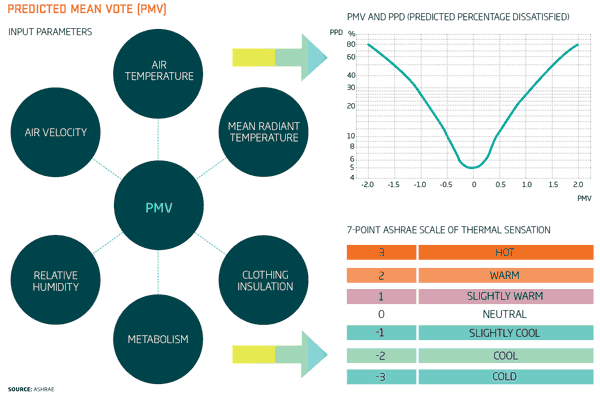 |
Â
Although technically correct, the laboratory-staged research and the standards it subsequently spawned established acceptable indoor temperature ranges that are much more narrow than those that have been tolerated by human populations for millennia. Furthermore, the research and standards make the assumption that occupants wearing similar clothes and doing similar activities will be equally comfortable with the same indoor conditions no matter where they are in the world. In the rational pursuit of an ideal temperature for all, the effort lost sight of the variations and complexities of people's day-to-day realities in different cultures and climates.
Unfortunately, one negative consequence of this conventional theory of comfort has been the increase in mechanical air-conditioning worldwide to attain that "ideal" temperature range, accompanied by a global increase in fossil-fuel consumption to keep these systems operating.
The Adaptive Model
While the conventional theory, with its bias towards a more uniform and rigid temperature range, took hold and spread throughout modern building standards and industry practices, not everyone was convinced that this static, "one-size-fits-all" approach was necessary or even optimal. For example, studies undertaken in the 1970s by Humphreys and Fergus Nicol, now a professor at the Low Energy Architecture Research Unit (LEARN) of the London Metropolitan University, suggested that the indoor temperature preferred by occupants around the world varied according to the current outdoor temperature. In other words, during the hotter summer months, an office worker would prefer a warmer indoor temperature than he or she would in the winter.
As concern for indoor environmental quality and energy conservation grew towards the end of the 20th century, interest also began to grow among more researchers and practitioners to reexamine the thermal-comfort assumptions embedded in the current standards and explore alternative ways to achieve high indoor environmental quality without wasting precious resources. An indication of this shift occurred in August 1994 in Windsor, UK, where an international group convened to discuss thermal comfort at the first of what has become a periodic gathering called the Windsor Conferences. The conferences are sponsored by the Network for Comfort and Energy Use in Buildings (NCEUB) and more information can be found at nceub.commoncense.info.
Human Adaptability
In "Thermal Comfort Temperatures and The Habits of Hobbits"-a paper from the book  Standards for Thermal Comfort: Indoor Air Temperature Standards for the 21st Century, edited by Fergus Nicol, Michael Humphreys, Oliver Sykes, and Susan Roaf (1995)-Humphreys argued that, "the adaptive, people-centered way of regarding thermal comfort suggests that it would be advantageous to reformulate temperature standards for buildings so that they reflect the empirical relation between climate and thermal comfort, and make due allowance for human adaptability."
One important study that came on the heels of this call for thermal common sense was undertaken by Gail S. Brager of the Center for Environmental Design Research, University of California, Berkeley, and Richard de Dear of the Division of Environmental and Life Sciences, Macquarie University, Sydney, Australia. With funding from ASHRAE, Brager and de Dear studied standardized thermal-related data from 160 office buildings in countries spanning four continents and representing a variety of climate zones, including Australia, Greece, Indonesia, Pakistan, Thailand, the U.S., and UK. The buildings fell into one of two categories: those with centrally controlled heating, ventilating, and air-conditioning systems (HVAC) in which occupants have little to no control over their immediate thermal environment; and those that were naturally ventilated (NV) with occupant-controlled operable windows and no mechanical air-conditioning. The database did not include enough mixed-mode buildings-those that combined mechanical and natural ventilation-to analyze this hybrid category.
In a paper titled "Climate, Comfort, & Natural Ventilation: A New Adaptive Comfort Standard for ASHRAE Standard 55," (2001), Brager and de Dear explain two dominant patterns that emerged from their data analysis: First, the comparison of observed responses in NV buildings to those of HVAC buildings "suggests that occupants of HVAC buildings become more finely adapted to the narrow, constant conditions typically provided by mechanical conditioning, while occupants of NV buildings prefer a wider range of conditions that more closely reflect outdoor climate patterns."
|
Â
Second, by comparing the observed responses to those predicted by the PMV model within each category, Brager and de Dear found that "PMV was remarkably successful at predicting comfort temperatures…in the HVAC buildings, demonstrating that behavioral adjustments of clothing and room air speeds (both of which are inputs to the PMV model) fully explained the relationship between indoor comfort temperature and outdoor climatic variation." In the NV buildings, however, the observed and predicted responses were notably different. The researchers suggest that the behavioral adjustments within the PMV model (i.e. clothing and room air speed) were not sufficient to make an accurate prediction in the case of the NV buildings and posit that a "psychological adaptation [that] is not accounted for by the PMV model" is at play. They go on to explain that, in their opinion, "indoor comfort temperatures in NV buildings are strongly influenced by shifting thermal expectations resulting from both higher levels of perceived control, and a greater diversity of thermal experiences in the building."
It appears that thermal comfort is not only a function of standard variables recognized by the conventional theory (the variables of air temperature, air velocity, mean radiant temperature, and relative humidity, and the personal variables of activity levels and clothing insulation), but is also affected by psychological variables ranging from people's expectations (due to, for example, outside conditions or cultural norms) to how much control they have over their immediate workspaces (by, for example, being able to open up a window, adjust blinds, or even move to a different location).
The Brager-de Dear study led to the incorporation of a new section into the 2004 version of Standard 55 to provide designers with a potential alternative to the traditional PMV-based comfort zone. Titled "5.3. Optional Method for Determining Acceptable Thermal Conditions in Naturally Conditioned Spaces," this optional method allows warmer indoor temperatures for naturally ventilated buildings during summer. Explains Gwelen Paliaga, senior mechanical designer at Taylor Engineering in Alameda, California, and current chair of ASHRAE Standard 55, the optional calculation method does not apply to buildings equipped with mechanical air-conditioning systems or during periods when mechanical heating systems are running.
Although Paliaga acknowledges that occupants in mixed-mode buildings likely experience some degree of psychological adaptation beyond the behavioral adjustments incorporated into the PMV model, he explains that, for now, "we can't include mixed-mode buildings in Standard 55's optional method, because the studies on these types of buildings have yet to be done."
Although section 5.3 may be incremental in scope, its inclusion in ASHRAE is significant. Not too long after ASHRAE acknowledged the adaptive theory with its 2004 version of Standard 55, the European community included an adaptive section in European Standard EN15251--"Indoor environmental input parameters for design and assessment of energy performance of buildings addressing indoor air quality, thermal environment, lighting and acoustics," published in 2007. Humphreys reports that, although it is still in the discussion stages, the thermal comfort standard that the Chinese are currently trying to establish is "largely adaptive in concept."
Going Forward
While proponents of adaptive thermal comfort welcome these advances as incremental steps toward reshaping the heating, ventilation, and air-conditioning practices that developed during a period of energy abundance into more sustainable approaches for a society facing peak oil, there is no doubt that there is still much more to learn within this multidisciplinary field, which sits at the crossroads of physics, physiology, psychology, culture, and climate.
Zooming down to the cellular level, for example, consider, the paper "Thermal Comfort in Natural Ventilation-A Neurophysiological Hypothesis," which was presented by Richard de Dear at the April 2010 Windsor conference. In it, de Dear explores the physiological phenomenon known as alliesthesia, a term coined by French physiologist Michel Cabanac in 1971 "to describe the phenomenon whereby a given stimulus can induce either a pleasant, or unpleasant sensation, depending on the subject's internal state." Research conducted at this physiological level suggests that humans may actually prefer experiencing a change towards a desired state more than experiencing the desired state itself. Like a diner who enjoys the act of eating more than the state of being full, a slightly overheated occupant may report being more comfortable when sensing a mild breeze that promises to cool him or her down to the desired temperature than when the desired, or "thermally neutral," temperature is actually achieved and statically maintained. At the end of the paper de Dear suggests that, "we need to understand allesthesia…to create thermal…comfort or even better, thermal delight."
|
Â
In contrast, zooming up to the scale of a building, consider yet another study recently undertaken by Katie Ackerly, a student in the Master of Science in Architecture program at University of California Berkeley, under the guidance of Brager, now associate director of the Center for the Built Environment at Berkeley (CBE) and CBE Director of Communications David Lehrer. Ackerly has been analyzing more than a dozen mixed-mode office buildings in the United States that were equipped with window-signaling systems that are intended to educate and motivate occupants to adjust the windows when such action is warranted. The goal is to understand how to optimize the window-control behavior of multiple occupants in conjunction with a building's mechanical system so that the individual's control of his or her personal environment -and therefore his or her comfort level--is maximized while any discomfort to others is minimized, hopefully along with reducing the building's overall energy bill.
|
Â
Clearly, these and many other types of empirical studies need to be carried out before designers can confidently create a built environment that can truly stay in sync with all its complex and dynamic human occupants. Until then, maybe a little bit of humility and basic common sense is in order.

